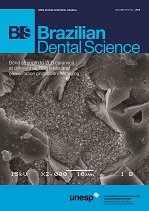Bond strength to ZLS ceramics at different etching times and cementation protocols after aging
DOI:
https://doi.org/10.14295/bds.2019.v22i4.1816Resumen
Objective: To assess the influence of 5% hydrofluoric acid etching time (ET), cementation protocol (CP), and thermal cycling (TC) aging on the microshear bond strength (µSBS) of zirconia-reinforced lithium silicate ceramic (ZLS) to adhesive resin cement. Material and Methods: Ten VITA Suprinity® ceramic blocks were cut in 120 slices (1.4 mm thickness) and randomly assigned to 12 groups (n = 10) according to the combination of factors (2x3x2 design): etching time (20 or 30 s), cementation protocol (silane + universal adhesive + resin cement; universal adhesive + resin cement; silane + resin cement) and thermal cycling (cycled or no-cycled). RelyX Ceramic Primer and Scotchbond™ Universal Adhesive were used respectively as silane (S) and universal adhesive (Ua). Ceramic surface was etched, and the cementation protocol performed on the delimited bonding area. Then, resin cement (RelyX™ Ultimate Cement [Rc]) cylinders were bonded and light cured. After, specimens were stored in deionized water at 37°C for 7 days and subjected to the µSBS test. Results: Data passed the normality test and three-way ANOVA analysis showed statistical difference (p<0.01) for isolated; double (ET/TC) (p<0.05), and triple (p<0.05) factor interactions. Conclusion: The combination 30s etching-Ua-Rc presented higher adhesive bond strength after thermal aging.
Descargas
Descargas
Archivos adicionales
Publicado
Cómo citar
Número
Sección
Licencia
Brazilian Dental Science uses the Creative Commons (CC-BY 4.0) license, thus preserving the integrity of articles in an open access environment. The journal allows the author to retain publishing rights without restrictions.
=================
COPYRIGHT TRANSFER AND RESPONSIBILITY STATEMENT
(PDF)
For all articles published in the BDS journal, copyright is retained by the authors. Articles are licensed under an open-access Creative Commons CC BY 4.0 license, meaning that anyone may download and read the paper for free. In addition, the article may be reused and quoted, provided that the original published version is cited. These conditions allow for maximum use and exposure of the work while ensuring that the authors receive proper credit. All metadata associated with published articles is released under the Creative Commons CC0 Universal Public Domain Dedication.
Before the submission, authors must obtain permission to reproduce any published material (figures, schemes, tables, or any extract of a text) that does not fall into the public domain or for which they do not hold the copyright. Permission should be requested by the authors from the copyright holder (usually the Publisher, please refer to the imprint of the individual publications to identify the copyright holder).
The authors hereby attest that the study is original and does not present manipulated data, fraud, or plagiarism. All names listed made a significant scientific contribution to the study, are aware of the presented data, and agree with the final version of the manuscript. They assume complete responsibility for the ethical aspects of the study.
This text must be printed and signed by all authors. The scanned version should be submitted as supplemental file during the submission process.
























